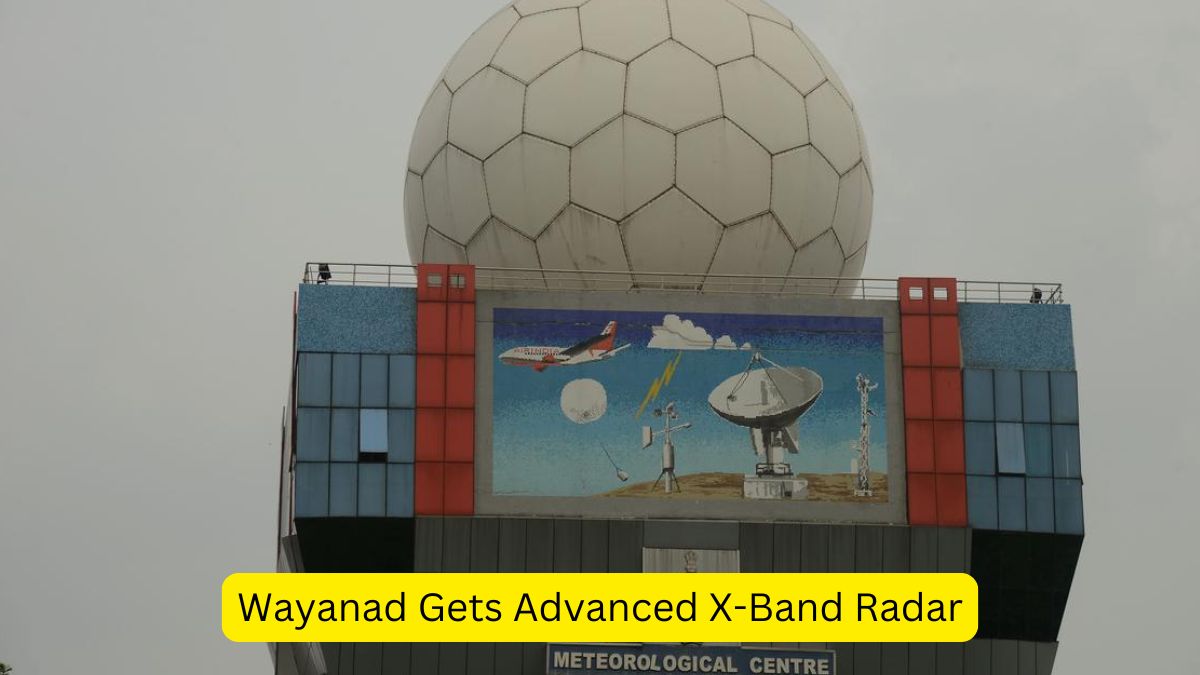After devastating floods and landslides claimed over 200 lives in Kerala’s Wayanad district in July 2024, the Union Ministry of Earth Sciences took a crucial step to bolster disaster preparedness by approving the installation of an X-band radar in the region. The torrential rains, which triggered a massive landslide in the valley above Punchirimattom near the Mundakkai area, led to catastrophic debris flows, intensifying the destruction.
Details
How do Radars Work?
- Radar stands for ‘radio detection and ranging’.
- It uses radio waves to detect objects, measure distance, velocity, and characteristics.
- A transmitter emits a signal aimed at an object (e.g., clouds in meteorology).
- The signal reflects off the object and returns to the radar’s receiver for analysis.
- This type of radar uses the Doppler effect, which is the change in frequency as the source of waves moves toward or away from a listener.
- It tracks cloud movement, direction, and speed based on frequency changes.
- Measures intensity (e.g., rainfall) by emitting radiation in pulses and analyzing how often they reflect back.
- This helps monitor wind patterns and storms.
X-Band Radar
X-band properties
- X-band radar operates in the 8-12 GHz range with wavelengths of 2-4 cm, offering higher-resolution images by using shorter wavelengths.
Applications in meteorology
- These radars detect smaller particles, like rain droplets or fog, due to their lower wavelengths.
Limitations
- X-band radar has a shorter range because higher frequency radiation attenuates faster.
Usage in Wayanad
- It will monitor soil movements to help predict landslides, performing high-temporal sampling to track changes rapidly.
India’s Radar Network
- India began using weather radars in the 1950s.
- The first indigenously made X-band radar was installed in New Delhi in 1970.
- X-band radar network: India uses X-band radars for storm and wind detection. Some radars have dual capabilities.
- S-band radars: Operate at 2-4 GHz and are used for long-range detection. The first cyclone detection S-band radar was set up in Visakhapatnam in 1970.
- Radar expansion: India is set to install 56 additional Doppler radars as part of the ₹2,000-crore ‘Mission Mausam’. This includes up to 60 meteorological radars by 2026.
- Northeast radar installation: The government is procuring 10 X-band Doppler radars to improve weather forecasting in northeastern states and Himachal Pradesh’s Lahaul and Spiti districts.
NISAR: A Joint NASA-ISRO Project
NISAR overview
- NASA and ISRO are collaborating on the NISAR satellite (NASA-ISRO Synthetic Aperture Radar) to map the Earth’s landmasses using radar imaging.
L- and S-band radar
- The satellite will carry an L-band radar (1.25 GHz, 24 cm) from NASA and an S-band radar (3.2 GHz, 9.3 cm) from ISRO to track natural changes on Earth.
Expected launch
- The satellite is planned for launch in 2025 aboard an ISRO GSLV Mk II rocket at a total cost of $1.5 billion, mostly funded by NASA.
| Summary/Static | Details |
| Why in the news? | Union Ministry of Earth Sciences took a crucial step to bolster disaster preparedness by approving the installation of an X-band radar in the region. |
| How Radars Work | Radar uses radio waves to detect objects, measure distance, velocity, and characteristics.
– The transmitter sends a signal, and the receiver analyzes the reflected signal using Doppler effect. |
| X-Band Radar Properties | – Operates in 8-12 GHz range with wavelengths of 2-4 cm.
– Provides higher-resolution images with shorter wavelengths. |
| Applications in Meteorology | – Detects smaller particles (e.g., rain droplets, fog).
– Monitors cloud movement, storm tracking, and intensity (e.g., rainfall). |
| Limitations of X-Band Radar | Shorter range due to rapid attenuation of higher frequency radiation. |
| NISAR Project – | Joint NASA-ISRO project to map Earth’s landmasses using radar imaging.
– Satellite will carry L-band (1.25 GHz) from NASA and S-band (3.2 GHz) from ISRO. |
| Expected Launch of NISAR | – Scheduled for 2025 via ISRO’s GSLV Mk II rocket.
– Total cost of $1.5 billion, mainly funded by NASA. |




 Non-Government NPS Subscribers Can Now W...
Non-Government NPS Subscribers Can Now W...
 Param Vir Dirgha at Rashtrapati Bhavan I...
Param Vir Dirgha at Rashtrapati Bhavan I...
 NHAI Introduces India’s First Wildlife-S...
NHAI Introduces India’s First Wildlife-S...







